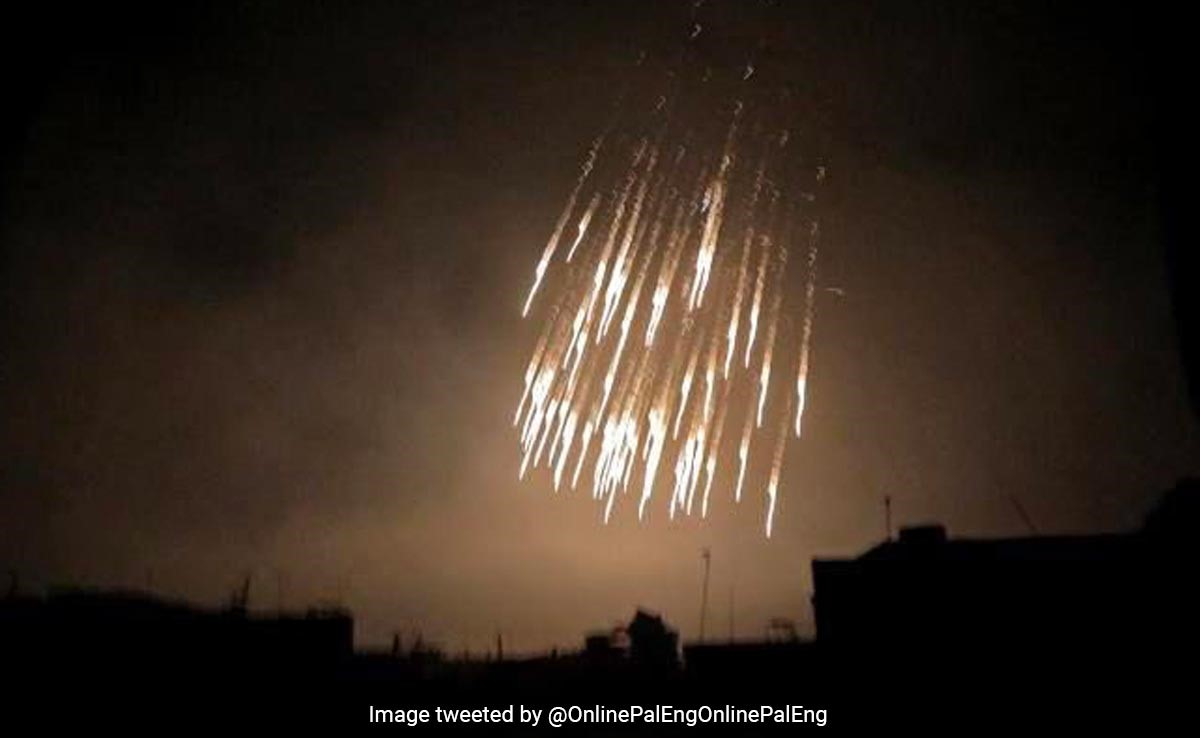
Disclaimer: Copyright infringement not intended.
Context
As Israel continued pounding targets in Gaza following the sensational land-sea-air assault on its territories by the Palestinian group Hamas, videos circulated on social media alleging that the Israel Defense Force (IDF) has been using banned white phosphorus bombs in the densely populated region.
Details
- White phosphorus is a highly reactive, waxy, and translucent solid with a characteristic pungent garlic-like odor.
- It is a chemical element with the symbol P and atomic number 15.
- Used in various industrial and military applications, white phosphorus is a versatile substance with a range of properties.
Chemical Properties
- White phosphorus exists in different allotropes and is the most reactive and least stable among all the elemental forms of phosphorus.
- It is insoluble in water but soluble in organic solvents, and it readily catches fire when exposed to air.
Industrial and Military Applications
- White phosphorus finds use in various industrial applications, including the manufacture of phosphoric acid, phosphorus trichloride, and other organic phosphorus compounds.
- In military contexts, it has been used in incendiary weapons, smoke screens, and tracer ammunition due to its pyrophoric properties.
Risks and Hazards
- Exposure to white phosphorus can lead to severe health hazards, including burns, necrosis, and other serious skin injuries. It can also cause systemic toxicity when ingested or inhaled.
- The combustion of white phosphorus produces phosphorus pentoxide, which can cause damage to the respiratory system upon inhalation.
.jpg)
Regulations and Control
- Due to its potential for misuse as a weapon and the associated health risks, the use and handling of white phosphorus are strictly regulated by various international agreements and conventions.
- The use of white phosphorus in warfare is governed by international humanitarian law, which restricts its use in certain contexts to prevent unnecessary harm to civilians and the environment.
- In 1972, United Nations labeled incendiary weapons, including white phosphorus, as instruments causing horrific and indiscriminate harm, leading to resolutions condemning their use.
- The 1980 international agreement established Protocol III, restricting the use of incendiary weapons that cause excessive harm to civilians and their property.
Environmental Impact
- The use of white phosphorus in warfare and industrial applications can lead to environmental contamination and long-term ecological damage, affecting soil and water quality.
- Efforts to mitigate the environmental impact of white phosphorus involve proper disposal, containment, and the development of alternative technologies to minimize its use.
Alternative Technologies and Substitutes
- Research and development efforts are focused on finding safer and more environmentally friendly substitutes for white phosphorus in various applications to reduce its potential risks and environmental impact.
- Alternative materials and technologies are being explored to replace white phosphorus in military and industrial applications, with a focus on improving safety and sustainability.
Historical Deployments in Warfare
- White phosphorus has a long history of use in warfare, dating back to the 1800s when it was employed by Irish nationalists against British forces, known as "Fenian fire."
- It was used by the British army in both World Wars, and the United States utilized it during the Iraq War, particularly in the city of Fallujah.
- Allegations of its use by the Israeli Defense Forces (IDF) in conflicts such as the 2006 Lebanon War and the 2008-09 Gaza War have garnered international attention and condemnation.
- The Syrian government, under Bashar Al-Assad, faced accusations of deploying white phosphorus during the Syrian crisis, and the Russian Army was recently accused of using it in the conflict with Ukraine.
About Phosphorous
Phosphorous is a highly reactive non-metal element that plays a crucial role in various biological, industrial, and environmental processes. Its importance spans across diverse fields, including agriculture, medicine, and manufacturing.
Chemical Properties:
- Phosphorous exists in several allotropic forms, the most common of which are white, red, and black phosphorus.
- It is highly reactive and forms compounds with a wide range of elements, including oxygen, sulfur, and metals.
- Phosphorous is essential for life and is a vital component of DNA, RNA, and ATP (adenosine triphosphate).
Importance in Biology:
- Phosphorus is an essential nutrient for the growth of plants and is a key component of fertilizers used in agriculture.
- It is crucial for the development of bones and teeth in humans and animals, playing a central role in skeletal structure and cellular processes.
Industrial Applications:
- Phosphorus compounds find use in various industrial processes, including the production of detergents, pesticides, and flame retardants.
- It is a vital component in the production of phosphoric acid, which is widely used in the food industry and in the manufacturing of fertilizers.
Environmental Significance:
- Phosphorus is a critical factor in the eutrophication of water bodies when excessive amounts of phosphorus enter aquatic systems through agricultural runoff and industrial waste.
- Efforts to manage and reduce phosphorus pollution focus on implementing sustainable agricultural practices, improving wastewater treatment, and promoting responsible use of phosphorus-based products.
Allotropic Forms:
- White phosphorus is a waxy, translucent solid, highly reactive and toxic, often used in chemical synthesis and military applications.
- Red phosphorus is a more stable form, utilized in the production of safety matches, flame retardants, and in the semiconductor industry.
- Black phosphorus exhibits semiconductor properties and is used in electronic and optoelectronic devices.
Discovery and History:
- Phosphorus was first isolated in 1669 by German alchemist Hennig Brand through the distillation of urine.
- Its discovery revolutionized the field of chemistry and contributed to the development of modern chemical principles.

Conclusion
The widespread deployment of white phosphorus in conflict zones has prompted widespread criticism and calls for stricter adherence to international humanitarian law. The ethical and moral concerns surrounding its use underscore the urgent need for enforcing international regulations to prevent further civilian harm and environmental devastation.
|
PRACTICE QUESTION
Q. Discuss the use of white phosphorus in warfare, its historical significance, and the ethical concerns associated with its deployment. Examine the international regulations governing its use and the measures necessary to ensure the protection of civilians and the environment in conflict zones. (250 Words)
|




